brakes BUICK CENTURY 1996 Owners Manual
[x] Cancel search | Manufacturer: BUICK, Model Year: 1996, Model line: CENTURY, Model: BUICK CENTURY 1996Pages: 340, PDF Size: 17.61 MB
Page 12 of 340
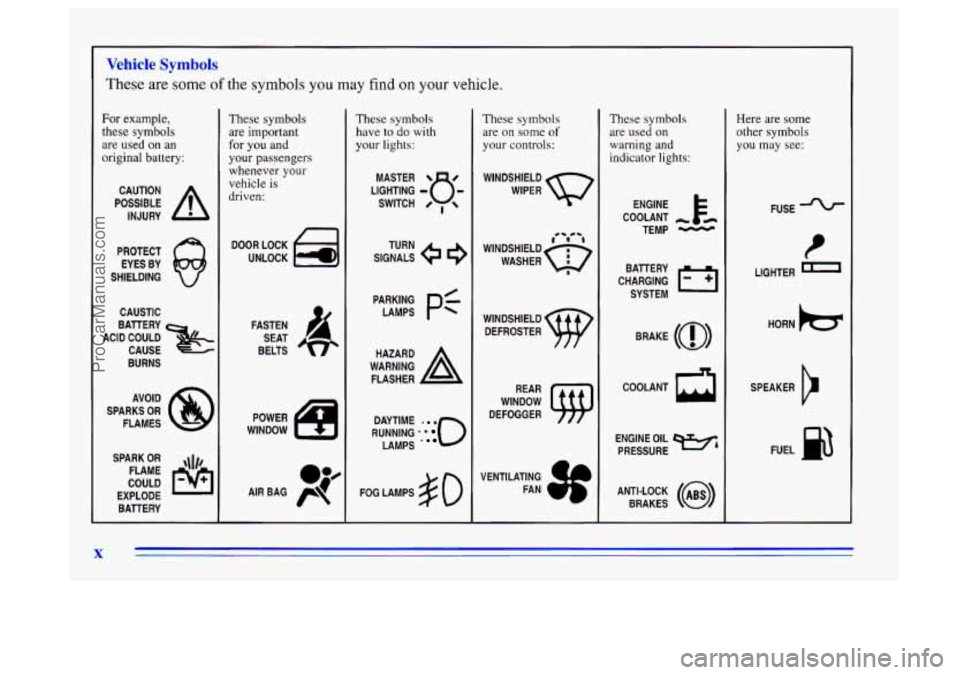
Vehicle Symbols
These are some of the symbols you may find on your vehicle.
For example,
these symbols
are used on an
original battery:
POSSIBLE A
CAUTION
INJURY
PROTECT EYES BY
SHIELDING
CAUSTIC
ACID COULD BATTERY
CAUSE
BURNS
SPARK
OR ,111,
COULD FLAME
EXPLODE BATTERY
These symbols
are important
for you and
your passengers
whenever your
vehicle is
driven:
DOOR LOCK
UNLOCK
POWER
WINDOW
These symbols have
to do with
your lights:
SIGNALS e e3
TURN
RUNNING
* ' 0
DAYTIME - a
LAMPS '
FOG LAMPS # 0
These symbols
are on some of
your controls:
WINDSHIELD
WIPER
WINDSHIELD DEFROSTER
VENTILATING FAN
These symbols are used on
warning and
indicator lights:
COOLANT
TEMP
-
CHARGING I-1
BATTERY
SYSTEM
BRAKE
(a)
COOLANT a
ENGINE OIL w,
PRESSURE
ANTI-LOCK
(@)
BRAKES
Here are some
other
symbols
you may see:
FUSE
P
LIGHTER
HORN
SPEAKER FUEL
p3
ProCarManuals.com
Page 76 of 340
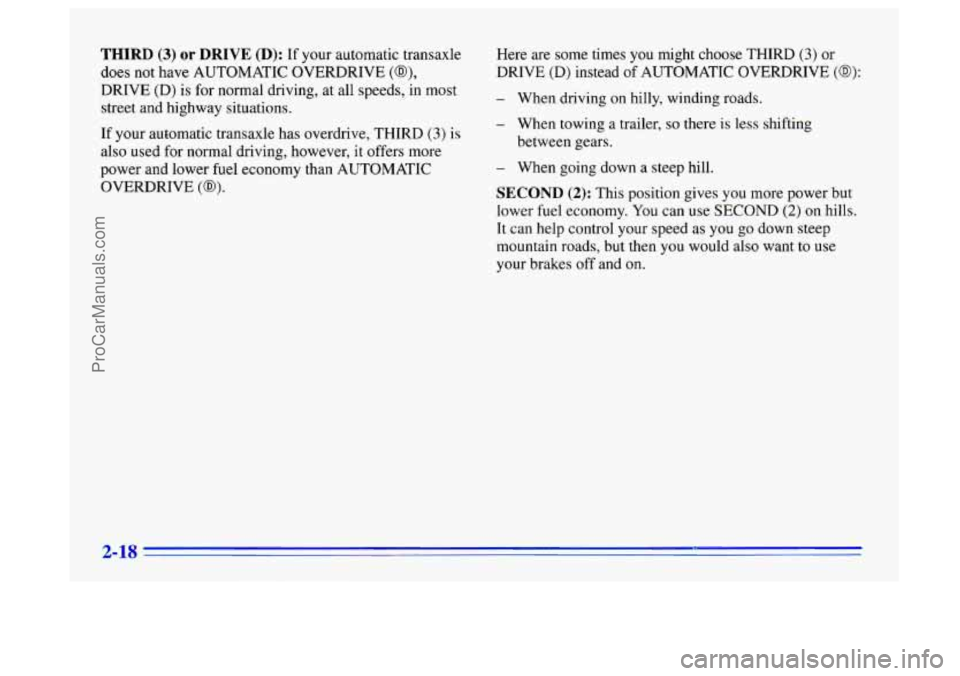
THIRD (3) or DRIVE (D): If your automatic transaxle
does not have AUTOMATIC OVERDRIVE
(@),
DRIVE (D) is for normal driving, at all speeds, in most
street and highway situations.
If your automatic transaxle has overdrive, THIRD
(3) is
also used for normal driving, however, it offers more
power and lower fuel economy than AUTOMATIC
OVERDRIVE
(a).
Here are some times you might choose THRD (3) or
DRIVE
(D) instead of AUTOMATIC OVERDRIVE (a):
- When driving on hilly, winding roads.
- When towing a trailer, so there is less shifting
between gears.
- When going down a steep hill.
SECOND (2): This position gives you more power but
lower fuel economy.
You can use SECOND (2) on hills.
It can help control your speed as you go down steep
mountain roads, but then
you would also want to use
your brakes off and on.
2-18
ProCarManuals.com
Page 77 of 340
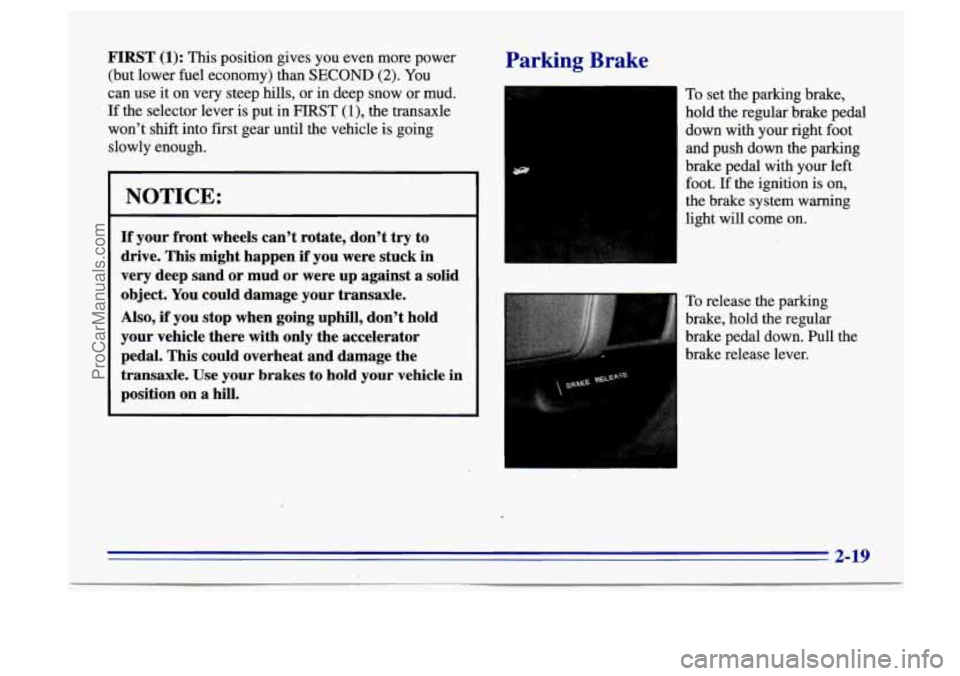
FIRST (1): This position gives you even more power
(but lower fuel economy) than
SECOND (2). You
can use it on very steep hills, or in deep snow or mud.
If the selector lever is put in FIRST (I), the transaxle
won’t shift into first gear until the vehicle is going
slowly enough.
NOTICE:
If your front wheels can’t rotate, don’t try to
drive. This might happen if you were stuck in
very deep sand or mud or were up against a solid
object.
You could damage your transaxle.
Also,
if you stop when going uphill, don’t hold
your vehicle there with only the accelerator
pedal. This could overheat and damage the
transaxle. Use your brakes to hold your vehicle in
position on a hill.
Parking Brake
To set the parking brake,
hold the regular brake pedal
down with your right foot
and push down the parking
brake pedal with your left
.foot. If the ignition is on,
the.brake system warning
light will come on.
To release the parking
brake, hold the regular
brake pedal down. Pull the
brake release lever.
2-19
ProCarManuals.com
Page 78 of 340
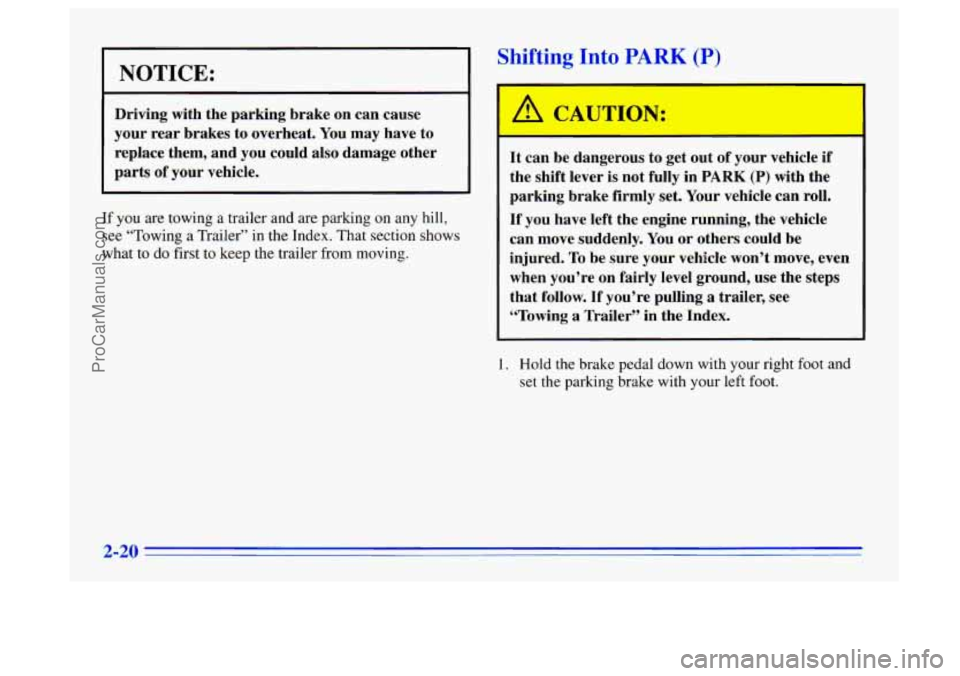
NOTICE:
Driving with the parking brake on can cause
your rear brakes to overheat.
You may have to
replace them, and you could also damage other
parts
of vour vehicle.
If you are towing a trailer and are parking on any hill,
see “Towing a Trailer” in the Index. That section shows
what to do first to keep the trailer from moving.
Shifti 3 In’ PAnK (P)
4
It can be dangerous to get out of your vehicle if‘
the shift lever is not fully in PARK (P) with the
parking brake
firmly set. Your vehicle can roll.
If you have left the engine running, the vehicle
can move suddenly.
You or others could be
injured.
To be sure your vehicle won’t move, even
when you’re on fairly level ground, use the steps
that
follow. If you’re pulling a trailer, see
“Towing
a Trailer” in the Index.
~
1. Hold the brake pedal down with your right foot and
set the parking brake with
your left foot.
2-20
ProCarManuals.com
Page 88 of 340
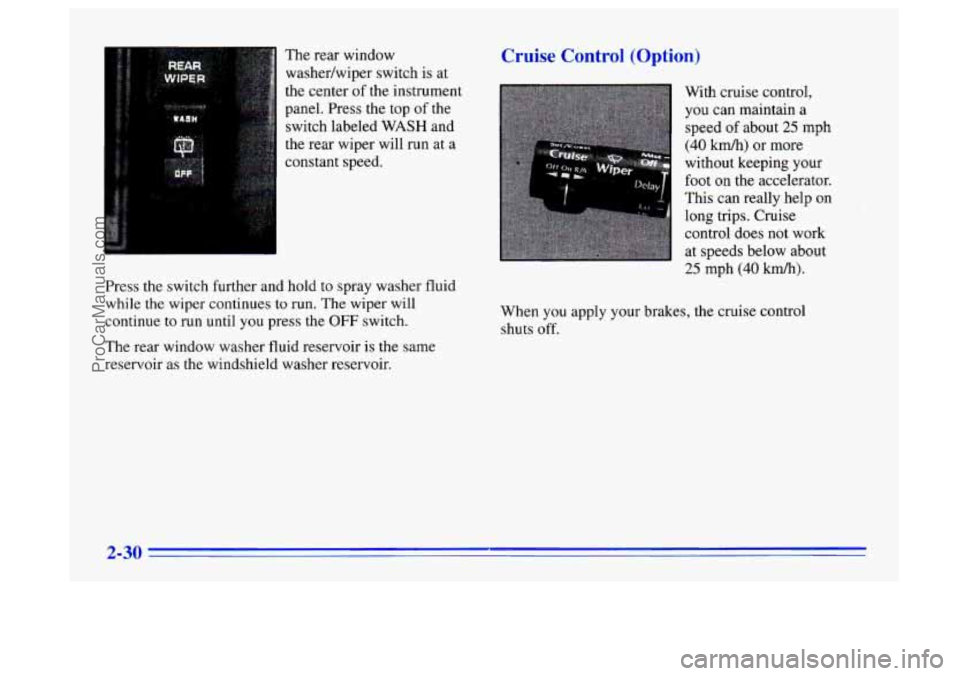
The rear window
washedwiper switch is at
the center of the instrument
panel. Press the top
of the
switch labeled
WASH and
the rear wiper will run at a
constant speed.
Press the switch further and hold
to spray washer fluid
while
the wiper continues to run. The wiper will
continue to run until you press the
OFF switch.
The rear window washer fluid reservoir is the same
reservoir as the windshield washer reservoir.
Cruise Control (Option)
With cruise control,
you can maintain
a
speed of about 25 mph
(40 km/h) or more
without keeping
your
foot on the accelerator.
This can really help on
long trips. Cruise
control does not work
at speeds below about
25 mph (40 km/h).
When you apply your brakes, the cruise control
shuts
off.
2-30
ProCarManuals.com
Page 110 of 340
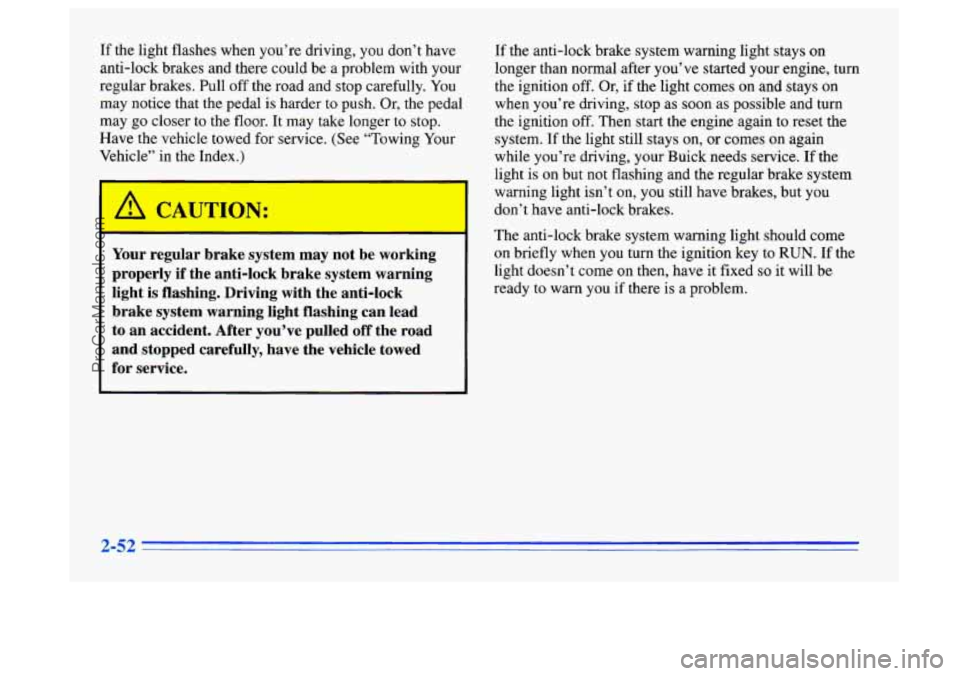
If the light flashes when you’re driving, you don’t have
anti-lock brakes and there could be a problem with your
regular brakes. Pull
off the road and stop carefully. You
may notice that the pedal is harder to push. Or, the pedal
may go closer to the floor. It may take longer
to stop.
Have the vehicle towed for service. (See “Towing Your
Vehicle” in the Index.)
I
Your regular brake system may not be working
properly if the anti-lock brake system warning
light is flashing. Driving with the anti-lock
brake system warning light flashing can lead
to an accident. After you’ve pulled off the road
and stopped carefully, have the vehicle towed
for service.
If the anti-lock brake system warning light stays on
longer than normal after you’ve started your engine, turn
the ignition
off. Or, if the light comes on and stays on
when you’re driving, stop as soon as possible and turn
the ignition off. Then start the engine again to reset the
system. If the light still stays
on, or comes on again
while you’re driving, your Buick needs service.
If the
light is on
but not flashing and the regular brake system
warning light isn’t on, you still have brakes, but you
don’t have anti-lock brakes.
The anti-lock brake system warning light should come
on briefly when
you turn the ignition key to RUN. If the
light doesn’t come
on then, have it fixed so it will be
ready
to warn you if there is a problem.
2-52
ProCarManuals.com
Page 135 of 340
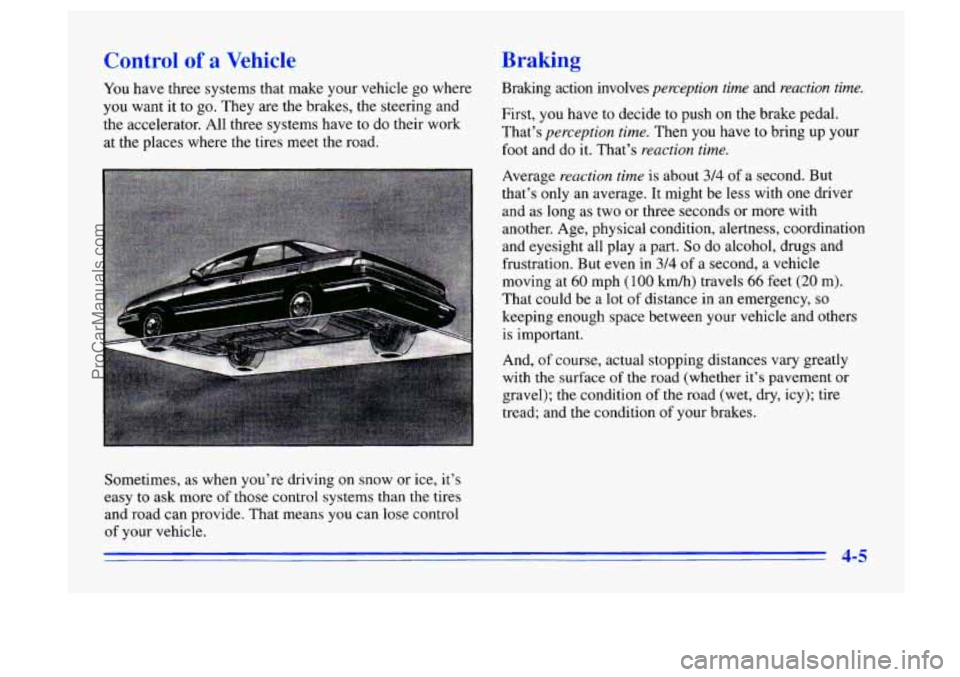
ktrol of a Vehicle BraE v
You have three systems that make your vehicle go where
you want it to go. They are the brakes, the steering and
the accelerator. All three systems have to do their work
at the places where the tires meet the road. Braking action involves perception time and reaction time.
First, you have to
decide to push on the brake pedal.
That’s perception time. Then you have to bring up your
foot and do it. That’s reaction time.
Sometimes, as when you’re driving on snow or ice, it’s
easy
to ask more of those control systems than the tires
and road can provide. That means you can lose control
of your vehicle. Average
reaction time
is about 3/4 of a second. But
that’s only an average. It might be less with
one driver
and as long as two or three seconds or more with
another. Age, physical condition, alertness, coordination
and eyesight all play a part.
So do alcohol, drugs and
frustration. But even in
3/4 of a second, a vehicle
moving at
60 mph (100 km/h) travels 66 feet (20 m).
That could be a lot of distance in an emergency, so
keeping enough space between your vehicle and others
is important.
And, of course, actual stopping distances vary greatly
with
the surface of the road (whether it’s pavement or
gravel); the condition
of the road (wet, dry, icy); tire
tread; and the condition of your brakes.
4-5
ProCarManuals.com
Page 136 of 340
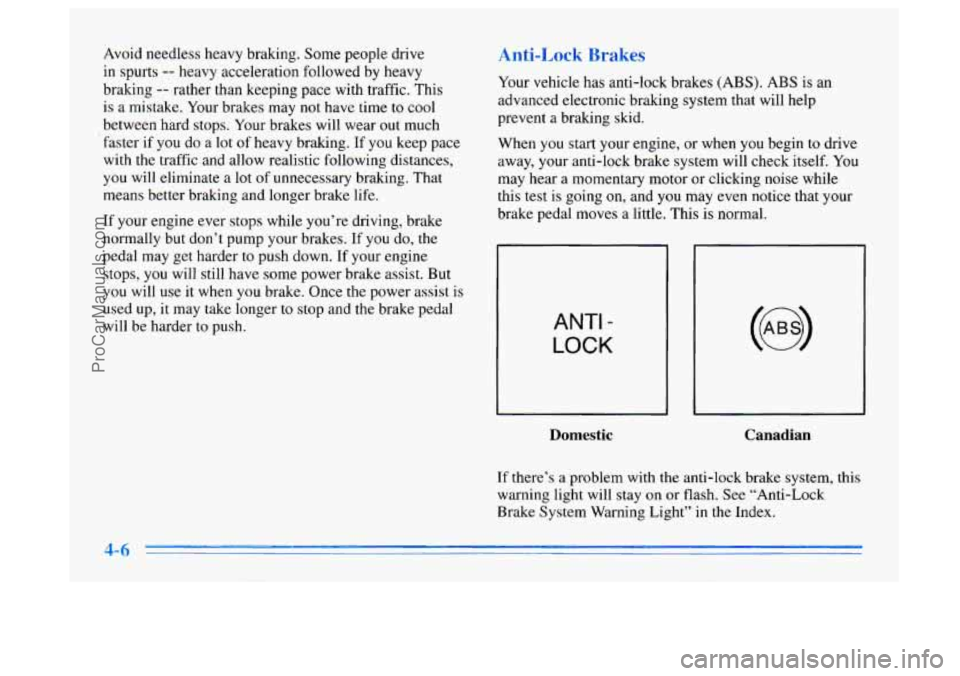
Avoid needless heavy braking. Some people drive
in spurts
-- heavy acceleration followed by heavy
braking
-- rather than keeping pace with traffic. This
is a mistake. Your brakes may not have time
to cool
between hard stops. Your brakes will wear out much
faster if you do
a lot of heavy braking. If you keep pace
with the traffic and allow realistic following distances,
you will eliminate
a lot of unnecessary braking. That
means better braking and longer brake life.
If your engine ever stops while you’re driving, brake
normally but don’t pump your brakes. If you do,
the
pedal may get harder to push down. If your engine
stops, you will still have some power brake assist. But
you will
use it when you brake. Once the power assist is
used up, it may take longer to stop and the brake pedal
will be harder to push. Your
vehicle has anti-lock brakes (ABS). ABS
is an
advanced electronic braking system that will help
prevent a braking skid.
When you start your engine, or when you begin to drive
away, your anti-lock brake system will check itself. You
may hear a momentary motor or clicking noise while
this test is going on, and you may even notice that your
brake pedal moves a little. This
is normal.
ANTI -
LOCK
Domestic Canadian
If there’s a problem with the anti-lock brake system, this
warning light will stay
on or flash. See “Anti-Lock
Brake System Warning Light” in the Index.
ProCarManuals.com
Page 137 of 340
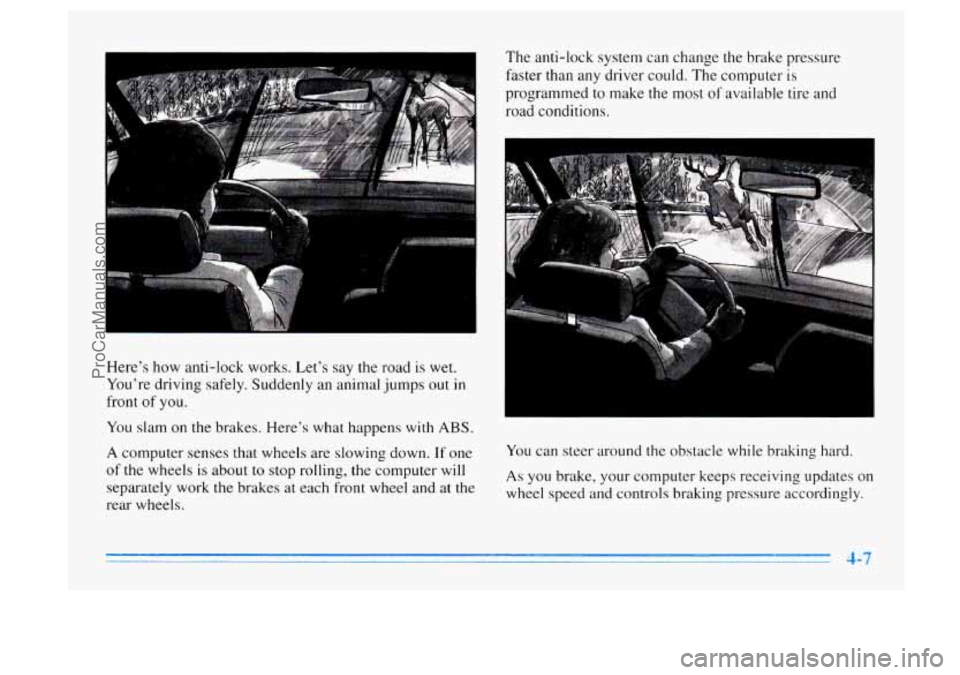
Here’s how anti-lock works. Let’s say the road is wet.
You’re driving safely. Suddenly an animal jumps out
in
front of you.
You slam on the brakes. Here’s what happens with
ABS.
A computer senses that wheels are slowing down. If one
of the wheels is about to stop rolling, the computer will
separately work the brakes at each front wheel and at the
rear wheels. The anti-lock system can change the
brake pressure
faster than any driver could. The computer
is
programmed to make the most of available tire and
road conditions.
You can steer around the obstacle while braking hard.
As you brake, your computer keeps receiving updates on
wheel speed and controls braking pressure accordingly.
ProCarManuals.com
Page 138 of 340
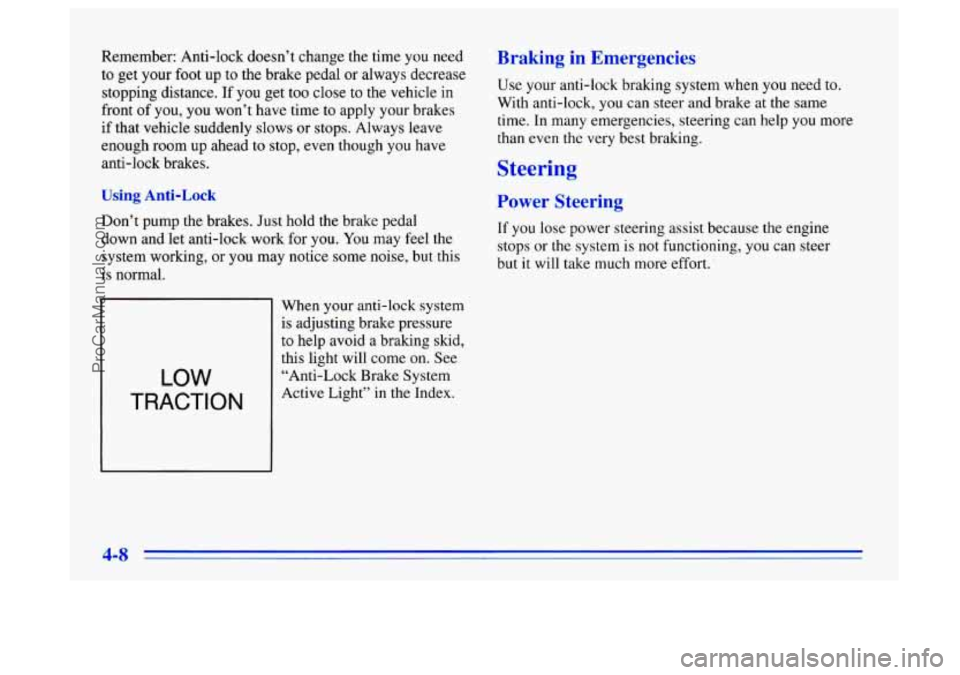
Remember: Anti-lock doesn’t change the time you need
to get your foot
up to the brake pedal or always decrease
stopping distance.
If you get too close to the vehicle in
front
of you, you won’t have time to apply your brakes
if that vehicle suddenly slows or stops. Always leave
enough room up ahead to stop, even though you have
anti-lock brakes.
Using Anti-Lock
Don’t pump the brakes. Just hold the brake pedal
down and let anti-lock work for you.
You may feel the
system working, or you may notice some noise, but this
is normal.
LOW
TRACTION
When your anti-lock system
is adjusting brake pressure
to help avoid a braking skid,
this light will come on. See
“Anti-Lock Brake System
Active Light” in the Index.
Braking in Emergencies
Use your anti-lock braking system when you need to.
With anti-lock, you can steer and brake at the same
time. In many emergencies, steering can help you more
than even the very best braking.
Steering
Power Steering
If you lose power steering assist because the engine
stops or the system is not functioning, you can steer
but it will take much more effort.’
.
4-8
ProCarManuals.com